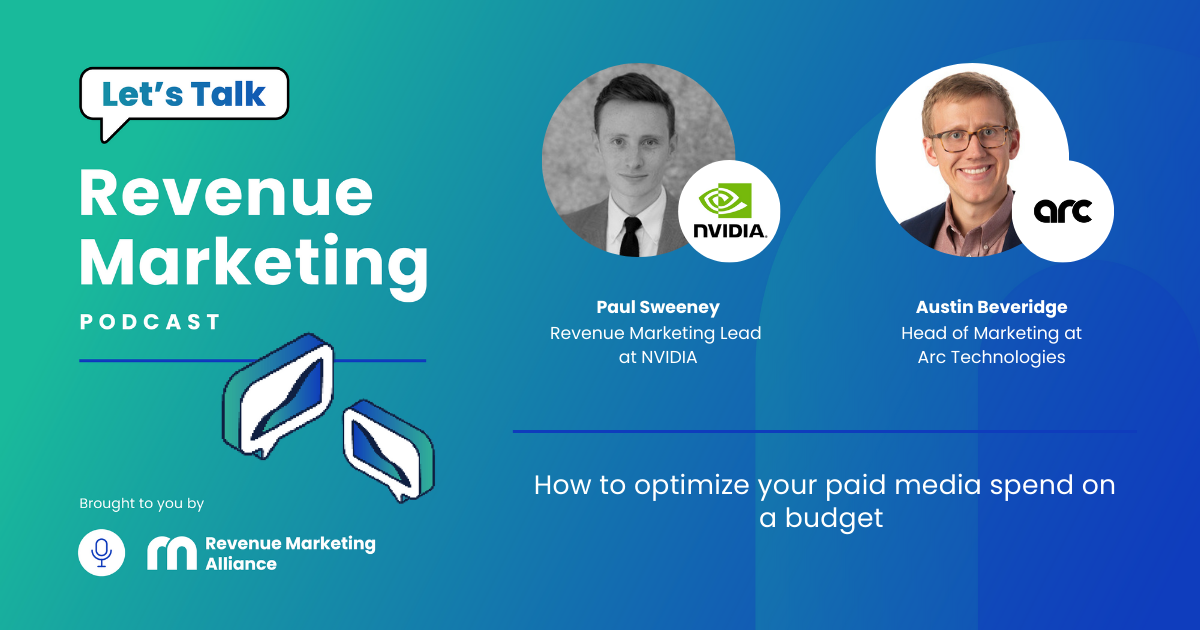Creating a marketing budget can be tough going: Where do you start? How do you negotiate the amount? How do you actually create a budget?
Of course, there are a lot of ways you can shout about your business without throwing a load of cash at different tools and platforms, but understanding marketing budgets and creating one that’s flawless goes a long way.
In this article, we’ll cover the following:
- Do I need a marketing budget?
- Types of budgeting: Top-down vs. bottom-up
- What is strategic budgeting in marketing?
Do I need a marketing budget?
Marketing is an essential component of any successful business strategy, and having a well-planned and adequately funded budget is crucial.
Without a dedicated budget for marketing efforts, it becomes challenging to reach your target audience, create brand awareness, and ultimately drive sales and revenue growth.
There’s a lot of competition out there, so companies across various industries and sectors invest in marketing to differentiate themselves from their competitors, establish a strong brand identity, and connect with potential customers.
Effective marketing requires a strategic approach that involves a combination of tactics, channels, and activities. From developing a compelling website and creating engaging content to leveraging social media platforms and running targeted advertising campaigns, each aspect of marketing requires a dedicated budget.

Without proper funding, your marketing efforts may lack the necessary resources to achieve their desired impact, leaving your business at a significant disadvantage.
With that in mind, having a well-defined and appropriately funded marketing budget is essential for businesses of all sizes and industries. It enables you to effectively communicate your value proposition, reach your target audience, and ultimately drive growth and profitability.
Source: Upflip
And with 85.8% of CMOs having faced budget cuts in the last year, it’s clear that marketing leaders need effective approaches to securing the resources they need.
There are two main styles of determining a budget – from upper management down, or lower-level employees up.
Both have their own pros and cons, and it’s crucial you understand them so you can adjust your budget negotiation methods depending on which way your company allocates the budget.
What is top-down budgeting?
Top-down budgeting is an approach where the overall marketing budget is determined by senior management or executive leadership based on factors such as overall company goals, revenue targets, and market conditions. This budget is then allocated across different marketing channels, campaigns, and initiatives.
In a top-down budgeting process, the high-level marketing budget is typically set first, and then marketing teams work within that predetermined budget to develop specific strategies and tactics. This approach often involves dividing the overall budget among different marketing functions or departments based on predetermined percentages or historical spending patterns.
It can be a straightforward method, but without input from employee, the budget may not be allocated as well as it could be. It may even cause issues between departments if one side feels like they haven’t been given the share of the budget they need.
What are the advantages of top-down budgeting?
Aligns with overall business goals
Top-down budgeting ensures that the marketing budget is aligned with the company's broader strategic objectives and financial constraints, ensuring that marketing efforts are focused on supporting the organization's overarching goals.
Efficient allocation of resources
By setting an overall budget first, top-down budgeting allows for a more efficient allocation of resources across different marketing initiatives, ensuring that funds are distributed appropriately based on priorities and potential impact.
Provides a clear spending framework
With a predetermined budget, marketing teams have a clear spending framework within which they must operate, encouraging fiscal discipline and responsible spending.
Enables agility and rapid decision-making
With the overarching budget set by senior leadership, marketing teams can pivot and adjust their strategies swiftly in response to market shifts or emerging opportunities.
This approach minimizes organizational delays and empowers teams to be nimble, capitalizing on time-sensitive opportunities without the need for protracted budget negotiations.
Fosters organizational alignment and cohesion
When the marketing budget is based on the company's broader strategic vision, it ensures that all marketing efforts are working toward a unified objective.
This cohesion not only streamlines resource allocation but also facilitates cross-functional collaboration, as teams across the organization can better understand and support the marketing initiatives that contribute to shared goals.
What are the disadvantages of top-down budgeting?
While top-down budgeting offers some great benefits, it is not without its drawbacks.
The potential for a disconnect
With top-down budgeting, there’s potential for a disconnect between the high-level budget and the granular realities faced by marketing teams on the ground.
Without input from those closest to the day-to-day operations, the predetermined budget may fail to account for nuanced requirements or emerging trends, leading to misaligned priorities or resource constraints.
This is why it’s essential for marketing leaders to work closely with their CFOs so they have an awareness of what marketing is actually for, and what resources it needs.
Disempowerment among marketing teams
Top-down budgeting can foster a sense of disempowerment among marketing teams if they feel that their specific needs and insights aren’t fully considered in the budgeting process.
This lack of involvement can lead to decreased motivation, ownership, and accountability, ultimately impacting the effectiveness of marketing initiatives and increasing turnover as people seek other opportunities.

Often inflexible
Top-down budgeting can be inflexible and slow to adapt to changing circumstances.
Think about it this way: If the predetermined budget is insufficient or misaligned with evolving market conditions or the tasks or activities you want to carry out, the company might have to go through lengthy processes to secure additional funding or reallocate resources. This can hinder your ability to respond swiftly to emerging opportunities or challenges.
What is bottom-up budgeting?
Bottom-up budgeting is a budgeting approach where individual marketing teams or departments determine their specific needs and requirements, and the overall marketing budget is then derived by aggregating the budgets of individuals or teams.
In this approach, each marketing team or functional area (e.g., social media, content marketing, email marketing, etc.) estimates the costs associated with their planned activities and campaigns. These individual budgets are then combined to form the overall marketing budget for the organization.
One issue with this method is having too many people involved can lead to lots of different options flying around and can leave the process scattered or stop them completely.
What are the advantages of bottom-up budgeting?
Granular and detailed budgeting
Bottom-up budgeting allows for a more granular and detailed approach to budgeting, as each marketing team or department provides specific insights into their requirements and costs, resulting in a more accurate and realistic budget.
Empowers marketing teams
By involving marketing teams in the budgeting process, bottom-up budgeting empowers them to take ownership of their initiatives and ensures that their specific needs are accurately represented in the overall budget.
Encourages accountability
When marketing teams are responsible for developing their own budgets, it fosters a sense of accountability and encourages them to carefully plan and justify their spending decisions.
A deeper understanding
Bottom-up budgeting can foster a deeper understanding of marketing requirements and costs. By involving the teams closest to the frontlines, bottom-up budgeting ensures that budgets are built upon a comprehensive grasp of the resources required to execute effective marketing strategies.
This is particularly true when departments are aligned; sales and marketing, for example, as your collective knowledge of operations translates into more realistic budget projections, minimizing the risk of under or over-allocating funds.

Cultivates buy-in and ownership
When teams are actively involved in shaping the budget, they develop a vested interest in the success of their initiatives and a deeper commitment to responsible spending.
This sense of ownership can translate into increased motivation, creativity, and a relentless pursuit of achieving the best possible results within the allocated resources.
What are the disadvantages of bottom-up budgeting?
Misalignment
The potential for misalignment with broader organizational goals and priorities can be significant. With each team or department advocating for its specific needs, the resulting budget may lack a cohesive, overarching strategy that aligns with the company's strategic vision and objectives.
Unrealistic expectations
Bottom-up budgets run the risk of budget inflation or unrealistic expectations. Without top-down guidance or constraints, individual teams may overestimate their resource requirements or fail to prioritize effectively, leading to inflated budgets that strain the organization's financial resources.
A time-consuming process
Bottom-up budgeting can be labor-intensive, requiring extensive coordination and negotiation among various teams and departments. This can lead to delays in finalizing the overall budget, potentially impacting the ability to execute timely campaigns or respond to market dynamics.
Striking the right balance between top-down strategic alignment and bottom-up operational insights is often the key to creating a marketing budget that is both responsible and effective.
Understanding the strengths and limitations of each approach will help you to develop a budgeting process that maximizes the benefits while mitigating the potential drawbacks.

What is strategic budgeting in marketing?
Your marketing strategy needs to make the most of your budget. You need to jump on emerging trends, grab fruitful opportunities, and drive sustainable growth, all while keeping everything afloat – and keeping an eye on your competitors.
Strategic budgeting in marketing essentially means allocating financial resources in a way that aligns with and supports the overall marketing strategy and goals of the organization. It involves careful planning and prioritization of marketing efforts to ensure that the budget is optimally utilized to achieve desired outcomes.
When you budget in a strategic way, you can maximize the impact of your marketing investments, ensure you’re consistently contributing to your goals, and remain a fierce market competitor.

When you create a strategic marketing budget, you need to allocate your funds based on specific marketing channels or tactics. This helps you to create a comprehensive plan that considers key factors like the company's objectives, target audience, competitive landscape, and overall business strategy.
Before we get to our final thoughts on top-down vs. bottom-up budgeting, let’s take a look at some essential channels and tactics that often come into play when you’re considering your marketing budget.
Key marketing channels
Events
Events, such as trade shows, conferences, and product launches, can be powerful marketing channels for generating leads, building brand awareness, and engaging with potential customers.
Content
Content marketing, including the creation and distribution of blog posts, reports, videos, and other valuable content, can help establish thought leadership, educate prospects, and drive inbound marketing efforts.
Social media
Social media platforms like Facebook, Twitter, LinkedIn, and Instagram provide opportunities for businesses to connect with their target audience, share content, and engage in conversations around their brand.
Email marketing campaigns, including newsletters, promotional offers, and nurturing sequences, can be effective in building relationships with prospects and customers, driving engagement, and ultimately generating conversions.
Influencers
Partnering with influential individuals, personalities, or communities in your industry can help amplify your brand's message and reach new audiences through their established followings.
Paid ads
Paid advertising channels, such as search engine marketing (SEM), display ads, and social media advertising, can be powerful tools for driving targeted traffic and generating leads when executed strategically.
You can quickly determine what’s working by taking a look at the pipeline generated by the source of the lead. So once you have a good idea of the best marketing channels, you can work on marketing tactics.
Key marketing tactics
Focusing on building your brand
Investing in brand-building activities, such as developing a strong visual identity, creating compelling messaging, and promoting brand values, can help differentiate your business and establish a lasting connection with your target audience.
Publishing targeted articles
Creating and publishing high-quality, informative articles and content that address the specific needs and interests of your target audience can help position your business as a thought leader and drive engagement.
Sending personalized emails
Personalized email campaigns that deliver relevant and tailored content based on customer data and behavior can improve engagement, build stronger relationships, and ultimately drive conversions.
Building a referral strategy
Developing a customer referral strategy that incentivizes existing customers to refer their friends, family, or colleagues to your business can be a cost-effective way to acquire new customers and expand your reach.
Building connections via social media
Engaging with your customers and building relationships through social media channels can help foster brand loyalty, gather valuable feedback, and create a sense of community around your brand.
Top-down vs. bottom-up budgeting: Final thoughts
At the end of the day, crafting an effective marketing budget boils down to finding the right balance between strategic vision and operational realities. It's about aligning your efforts with the company's overarching goals while ensuring that the nitty-gritty details aren't overlooked.
Whether you favor a top-down or bottom-up approach, the key is to foster collaboration, accountability, and a shared understanding of what it takes to drive real results. Don't get bogged down in endless meetings or bureaucratic red tape – stay agile, data-driven, and focused on maximizing the impact of every dollar spent.
Remember, your marketing budget isn't just a collection of numbers on a spreadsheet; it's the fuel that powers your ability to connect with your audience, amplify your brand's voice, and ultimately drive growth.



 Follow us on LinkedIn
Follow us on LinkedIn



